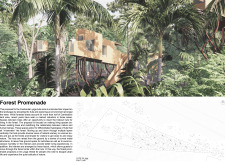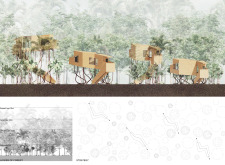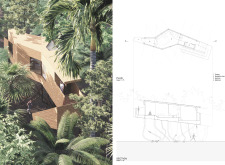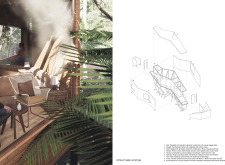5 key facts about this project
The Cambodian yoga huts project is a well-thought-out design located in a lush forest area. The purpose of these huts is to create special spaces for yoga and reflection, allowing visitors to connect with nature. The overall idea is to find a balance between human needs and the natural environment. By taking this approach, the design aims to enhance the experience of being surrounded by the forest.
Design Concept
The design focuses on creating a respectful relationship between the huts and the surrounding landscape. Situated among trees, the structures help preserve the ecological balance of a region that has been losing its forest cover. Elevating the huts minimizes their footprint on the ground, which protects the plants and animals residing in the area. This thoughtful placement provides unique spaces that blend well with the natural environment.
Spatial Arrangement
The layout of the huts is created to encourage exploration. Different levels allow visitors to enjoy various views of the forest. Inside, linear pathways guide movement and create a natural flow through the space. This arrangement not only makes it easy to navigate but also promotes mindfulness, which is an essential part of practicing yoga. Each hut serves as a stop along a pathway, inviting guests to engage with the beauty of the surroundings.
Material Selection
Material choice is essential for the huts' functionality and appearance. The roofs and walls are made from laminated waterproof wooden bars, ensuring protection from the weather while being visually pleasing. Stainless steel window frames allow natural light to enter and give a modern touch. Inside, polished hardwood tiles provide a durable and moisture-proof flooring solution. Glass features on the terraces connect the interior with the outdoor space, enhancing the overall experience.
Structural Innovation
Raising the huts allows for clear ground-level areas that can be used for different activities. This design choice offers more flexibility and does not disrupt the natural landscape. By elevating the structures, the design encourages diverse experiences, from quiet reflection to group activities. The careful integration of the huts within the forest promotes comfort while maintaining a strong connection to nature.
Light plays an important role in the design. Sunlight filtering through the trees creates shifting patterns on the walls and floors, enriching the atmosphere inside the huts. This blend of light and shadow invites guests to pause and enjoy their surroundings, making the experience even more meaningful.





















































